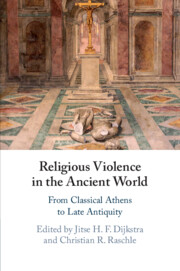Book contents
- Religious Violence in the Ancient World
- Religious Violence in the Ancient World
- Copyright page
- Contents
- Acknowledgements
- List of Contributors
- A Note on Abbreviations
- General Introduction
- Part I Methodology
- Part II Religious Violence in the Graeco-Roman World
- Part III Religious Violence in Late Antiquity
- Chapter 10 Religious Violence in Late Antiquity: Current Approaches, Trends and Issues
- Chapter 11 Coercion in Late Antiquity: A Brief Intellectual History
- Chapter 12 Crowd Behaviour and the Destruction of the Serapeum at Alexandria in 391/392 ce
- Chapter 13 Violence and Monks: From a Mystical Concept to an Intolerant Practice (Fourth to Fifth Century)
- Chapter 14 The Discipline of Domination: Asceticism, Violence and Monastic Curses in Theodoret’s Historia Religiosa
- Chapter 15 Suffering Saints: Shaping Narratives of Violence after Chalcedon
- Chapter 16 Fighting for Chalcedon: Vitalian’s Rebellion against Anastasius
- Chapter 17 The Emperor, the People and Urban Violence in the Fifth and Sixth Centuries
- Index of Sources
- General Index
Chapter 15 - Suffering Saints: Shaping Narratives of Violence after Chalcedon
from Part III - Religious Violence in Late Antiquity
Published online by Cambridge University Press: 18 September 2020
- Religious Violence in the Ancient World
- Religious Violence in the Ancient World
- Copyright page
- Contents
- Acknowledgements
- List of Contributors
- A Note on Abbreviations
- General Introduction
- Part I Methodology
- Part II Religious Violence in the Graeco-Roman World
- Part III Religious Violence in Late Antiquity
- Chapter 10 Religious Violence in Late Antiquity: Current Approaches, Trends and Issues
- Chapter 11 Coercion in Late Antiquity: A Brief Intellectual History
- Chapter 12 Crowd Behaviour and the Destruction of the Serapeum at Alexandria in 391/392 ce
- Chapter 13 Violence and Monks: From a Mystical Concept to an Intolerant Practice (Fourth to Fifth Century)
- Chapter 14 The Discipline of Domination: Asceticism, Violence and Monastic Curses in Theodoret’s Historia Religiosa
- Chapter 15 Suffering Saints: Shaping Narratives of Violence after Chalcedon
- Chapter 16 Fighting for Chalcedon: Vitalian’s Rebellion against Anastasius
- Chapter 17 The Emperor, the People and Urban Violence in the Fifth and Sixth Centuries
- Index of Sources
- General Index
Summary
Most Christians in Late Antiquity understood imperially sanctioned violence against the earliest Christians as the unjustified persecution of martyrs by an empire that was at odds with God.1 Nevertheless, Christians in positions of power after the rise of the Emperor Constantine (306–37) often explained imperially sanctioned violence against their religious opponents as the justified suppression of heresy, a narrative that complicated the position of Christians who rejected imperial orthodoxy, such as those who denounced the legitimacy of the Council of Chalcedon after 451.
- Type
- Chapter
- Information
- Religious Violence in the Ancient WorldFrom Classical Athens to Late Antiquity, pp. 345 - 366Publisher: Cambridge University PressPrint publication year: 2020

